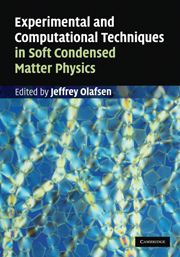Book contents
- Frontmatter
- Contents
- Contributors
- 1 Microscopy of soft materials
- 2 Computational methods to study jammed systems
- 3 Soft random solids: particulate gels, compressed emulsions, and hybrid materials
- 4 Langmuir monolayers
- 5 Computer modeling of granular rheology
- 6 Rheological and microrheological measurements of soft condensed matter
- 7 Particle-based measurement techniques for soft matter
- 8 Cellular automata models of granular flow
- 9 Photoelastic materials
- 10 Image acquisition and analysis in soft condensed matter
- 11 Structure and patterns in bacterial colonies
- Index
- References
1 - Microscopy of soft materials
Published online by Cambridge University Press: 05 July 2014
- Frontmatter
- Contents
- Contributors
- 1 Microscopy of soft materials
- 2 Computational methods to study jammed systems
- 3 Soft random solids: particulate gels, compressed emulsions, and hybrid materials
- 4 Langmuir monolayers
- 5 Computer modeling of granular rheology
- 6 Rheological and microrheological measurements of soft condensed matter
- 7 Particle-based measurement techniques for soft matter
- 8 Cellular automata models of granular flow
- 9 Photoelastic materials
- 10 Image acquisition and analysis in soft condensed matter
- 11 Structure and patterns in bacterial colonies
- Index
- References
Summary
Introduction
“Soft materials” is a loose term that applies to a wide variety of systems we encounter in our everyday experience, including:
• Colloids, which are microscopic solid particles in a liquid. Examples include toothpaste, paint, and ink.
• Emulsions, which are liquid droplets in another immiscible liquid, for example milk and mayonnaise. Typically a surfactant (soap) molecule or protein is added to prevent the droplets from coalescing.
• Foams, which are air bubbles in a liquid. Shaving cream is a common example.
• Sand, composed of large solid particles in vacuum, air, or a liquid; examples of the latter include quicksand and saturated wet sand at the beach.
• Gels are cross-linked polymers such as gelatin, or sticky colloidal particles. Usually the components of a gel (the polymers or particles) are at low concentration, but the gel still is elastic-like due to strong attractive forces between the gel components.
One common feature to all of these materials is that they are all comprised of objects of size 10 nm–1 mm; that is, objects much larger than atoms. In fact, it is these length scales that gives them their softness, as a typical elastic modulus characterizing these sorts of materials is kBT/a3, where kB is Boltzmann's constant, T is the absolute temperature, and a is the size of the objects the material is made from [1].
- Type
- Chapter
- Information
- Publisher: Cambridge University PressPrint publication year: 2010



